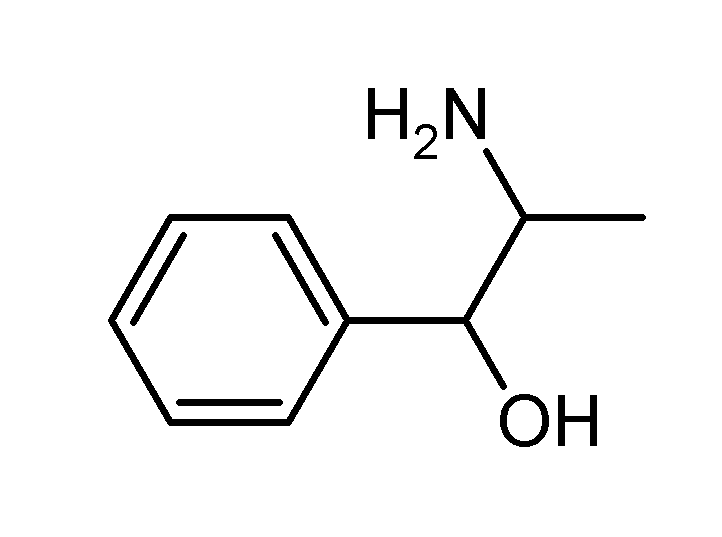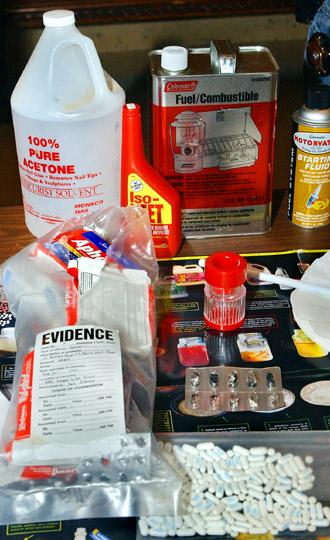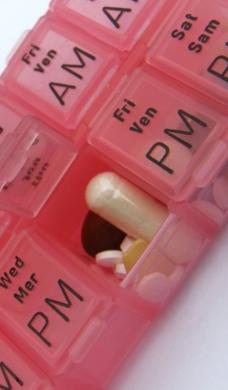|
HOME >>
API >>
Phenyl Propanolamine

Phenyl Propanolamine BP/USP

 Item
Number : PH157 Item
Number : PH157
CAS Number : 154-41-6
Molecular Formula : C9H13NO.HCl
Molecular Weight : 187.67
Synonyms (1RS,2SR)-2-Amino-1-phenylpropan-1-ol Hydrochloride; (+/-)-Norephedrine
Hydrochloride
Phenylpropanolamine is a decongestant. It works by
constricting (shrinking) blood vessels (veins and arteries) in your
body. Constriction of blood vessels in your sinuses, nose, and chest
allows drainage of those areas, which decreases congestion.
Phenylpropanolamine is used to treat the congestion associated with
allergies, hay fever, sinus irritation, and the common cold.
Phenylpropanolamine also causes a decrease in appetite and is used
in some over-the-counter diet aids.
Phenylpropanolamine has been associated with an increased risk of
hemorrhagic stroke (bleeding into the brain or into tissue
surrounding the brain) in women. Men may also be at risk. Although
the risk of hemorrhagic stroke is low, the U.S. Food and Drug
Administration (FDA) recommends that consumers not use any products
that contain phenylpropanolamine.
Additional Information
DEA scheduled list 1 chemical. Subject to procurement quota
requirements
Phenylpropanolamine (PPA;
Accutrim, Dexatrim), also knwon as norephedrine
and oxyamphetamine, is a
psychoactive drug of the
phenethylamine and
amphetamine
chemical classes which is used as a
stimulant,
decongestant, and
anorectic agent.[1][2]
It is commonly used in
prescription and
over-the-counter
cough and cold preparations. In
veterinary medicine, it is used to control
urinary incontinence in dogs under
trade names Propalin and Proin.
PPA acts as a
potent and
selective
releasing agent of
norepinephrine and
epinephrine, or as a
norepinephrine releasing agent (NRA). It also acts as a
dopamine releasing agent (DRA) to a lesser extent.
INTERACTIONS WITH OTHER DRUGS
In some cases of urinary incontinence, phenylpropanolamine is used
in combination with diethylstilbesterol (an estrogen). No harmful
drug interactions are expected with this combination.
Phenylpropanolamine should not be used with L-Deprenyl (Anipryl) due
to resulting unpredictable fluctuations in blood pressure.
It is recommended that phenylpropanolamine be withdrawn for 2 weeks
preceding the use of L-Deprenyl.
An increased risk of hypertension can also occur if
phenylpropanolamine is given in conjunction with tricyclic
antidepressants (such as amitriptyline), non-steroidal
anti-inflammatory drugs (NSAIDs), or amitraz (active ingredient of
the Preventic tick control collar and canine Promeris, a flea
control product).
Storage Information
LIGHT SENSITIVE: Keep tightly closed in light-resistant containers.
The Food and Drug Administration (FDA) has
taken steps to remove phenylpropanolamine from all drug products and
has issued a public health advisory concerning phenylpropanolamine
hydrochloride. This drug is an ingredient used in many
over-the-counter (OTC) and prescription cough and cold medications
as a decongestant and in over-the-counter weight loss products.
Phenylpropanolamine has been found to increase the risk of
hemorrhagic stroke (bleeding into the brain or into tissue
surrounding the brain) in women. Men may also be at risk. Although
the risk of hemorrhagic stroke is very low, FDA recommends that
consumers not use any products that contain phenylpropanolamine.
Summary of Interactions with Vitamins, Herbs, and Foods
In some cases, an herb or supplement may appear in more than one
category, which may seem contradictory. For clarification, read the
full article for details about the summarized interactions.
 Note:
These API/ chemicals are designated as those that are
used in the manufacture of the controlled substances and are important
to the manufacture of the substances. For any (Control Substance)
products Import and Export *** subjected to your country government laws
/control substance ACT. Note:
These API/ chemicals are designated as those that are
used in the manufacture of the controlled substances and are important
to the manufacture of the substances. For any (Control Substance)
products Import and Export *** subjected to your country government laws
/control substance ACT.
Note /Government
Notification: These chemicals are designated as those that are
used in the manufacture of the controlled substances and are
important to the manufacture of the substances. For any (Control
Substance) products Import and Export *** subjected to your
country government laws /control substance ACT.
Information: The information on this web page is provided to
help you to work safely, but it is intended to be an overview of
hazards, not a replacement for a full Material Safety Data Sheet
(MSDS). MSDS forms can be downloaded from the web sites of many
chemical suppliers. ,also that the information on the PTCL
Safety web site, where this page was hosted, has been copied
onto many other sites, often without permission. If you have any
doubts about the veracity of the information that you are
viewing, or have any queries, please check the URL that your web
browser displays for this page. If the URL begins "www.tajapi.com/www/Denatonium
Benzoate.htm/" the page is maintained by the Safety Officer in
Physical Chemistry at Oxford University. If not, this page is a
copy made by some other person and we have no responsibility for
it.
The Controlled Substances Act (CSA) was enacted into law by the
Congress of the United States as Title II of the Comprehensive
Drug Abuse Prevention and Control Act of 1970.[1] The CSA is the
federal U.S. drug policy under which the manufacture,
importation, possession, use and distribution of certain
substances is regulated. The Act also served as the national
implementing legislation for the Single Convention on Narcotic
Drugs.


|


Phenylpropanolamine
Article
Also indexed as:
Acutrim, Dex-A-Diet, Dexatrim, Phenldrine,
Phenoxine, PPA, Propagest, Rhindecon, Unitrol
Combination drugs: Ami-Tex LA, Appedrine, Contac 12 Hour, DayQuil
Allergy Relief, Dex-A-Diet Plus Vitamin C, Diadex Grapefruit Diet
Plan, Dimetapp, Entex LA, Robitussin CF, Tavist-D, Triaminic-12
Skip to:
* Introduction
* Interactions summary
* Herb interactions
* Food interactions
* References
Phenylpropanolamine is a drug used to relieve nasal congestion due
to colds, hay fever, upper respiratory allergies, and sinusitis.
It is available in nonprescription products alone and in
combination with other nonprescription drugs, to treat symptoms of
allergy, colds, and upper respiratory infections.
Phenylpropanolamine is also used as an adjunct to calorie
restriction in short-term weight loss. It is available in
nonprescription products alone and in combination with other
ingredients for weight loss.
|




 Item
Number : PH157
Item
Number : PH157








